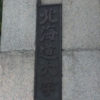阪急の小林一三邸がある。
大阪

■宝塚グラフって昔見たことある。

■モダンって左から。

■世界地図
阪急や宝塚の資料。
たとえば、

■京阪神急行です。私鉄3社が全部って?

■西宮球場

■とりあえず急行です。

■路線図です。
海外視察等で知り得た海外文化。
有名なのは阪急電鉄で その構想は小林が海外視察とかで勉強した結果だと思うが、街を作り 街をつなぐ電車を作り、面白いのはその駅えきに娯楽や百貨店を作った。

■阪急百貨店


■阪急百貨店の中のあんないでしょうか?

■箕面市のなんか?
チタシ等の絵柄が面白い。
その文化の流れの中で

■小林の写真?
昔の写真もある。
昔の写真なんかもあって

■昔の電車

■昔の文献資料です。その他たくさん!
The old leaflets and items in the Kobayashi Ichizo residence museum are interesting. As expected, the person who made Hankyu and Takarazuka is a big conglomerate.
There is Ichizo Kobayashi residence of Hankyu.
There is an old house of “Ichizo Kobayashi” in the hills of Ikeda, Osaka, and now it feels like a memorial hall where you can see the inside. But it’s interesting, or rather, it’s very interesting because there are flyers that are familiar to the people of Osaka.
Materials of Hankyu and Takarazuka.
For example, things related to Hankyu trains, things related to Hankyu department stores, things related to operas, things related to Toho, Nishinomiya stadium, things related to overseas travel, and many others. Kobayashi was a businessman in the Meiji era who built a railway in Kansai with his financial power, especially starting with a bank.
Overseas culture that I learned from overseas inspections.
The famous one is Hankyu Railway, and I think Kobayashi’s idea is the result of studying abroad, but he built a town, made a train that connects the town, and interestingly, made an entertainment and a department store at the station. Movies, amusement parks, stadiums, people’s means of transportation, stations, houses and entertainment, this created people’s lives and created a culture. And he can only do that as a banker. The same thing is repeated in this day and age.
Patterns such as chitashi are interesting.
Within that cultural flow, the designs on flyers, books, signboards, etc. from the Meiji, Taisho, and Showa eras are interesting, or rather, distinctive and interesting. Maybe people in the old days were delicate, but he has really good patterns and colors. Nowadays, the technology is excellent, so it may be easy to make, but in the past, it was analog, and the pattern of each character was wonderful.
There are also old photos.
There are also old photos, such as the old Umeda neighborhood, Hankyu Department Store like this, world maps, Takarazuka, and event guides. From Juso on the Shinkeihan line to Kyoto and Sonoda residential area sales leaflets. In Keihan, Hankyu and Hanshin used to be the same railway company, but after that, they split off separately, but now the coastal and mountainous areas are completely different, but… Did he start this Keihan Electric Railway because of such a past? I like him, who makes you feel history and has interesting designs.

